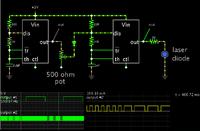devank.purohit
Newbie level 6
I wish to drive a LASER diode with the following input specifications:
1. A constant current of 50 - 120 mA
2. Forward voltage is 1.1 - 1.5V
The LASER diode has to be driven by a signal (MIX_OUT in the schematic attached) whose frequency is (9/11/15/18) KHz for the first 5 ms and 21 KHz for the next 5 ms. The problem is I have tried using a normal transistor configuration, darlington pair configuration but have been unable to achieve the desired results. Any help would be greatly appreciated.
1. A constant current of 50 - 120 mA
2. Forward voltage is 1.1 - 1.5V
The LASER diode has to be driven by a signal (MIX_OUT in the schematic attached) whose frequency is (9/11/15/18) KHz for the first 5 ms and 21 KHz for the next 5 ms. The problem is I have tried using a normal transistor configuration, darlington pair configuration but have been unable to achieve the desired results. Any help would be greatly appreciated.
Attachments
Last edited by a moderator:
